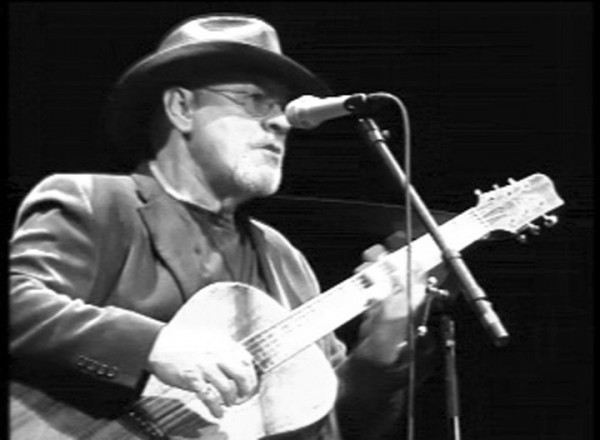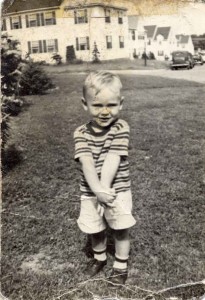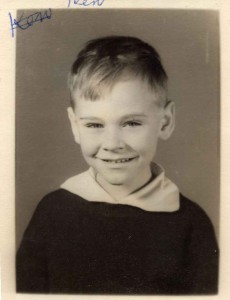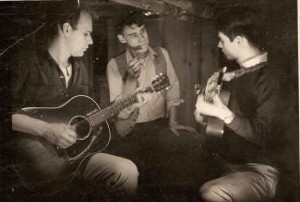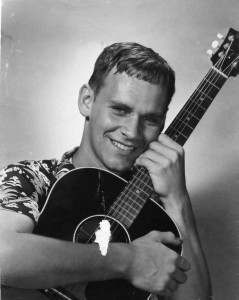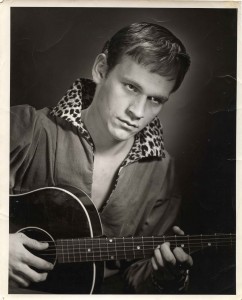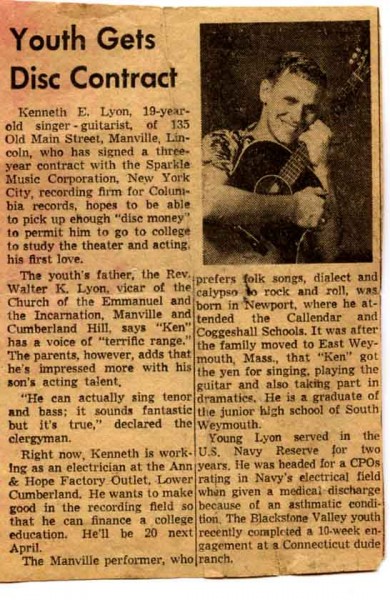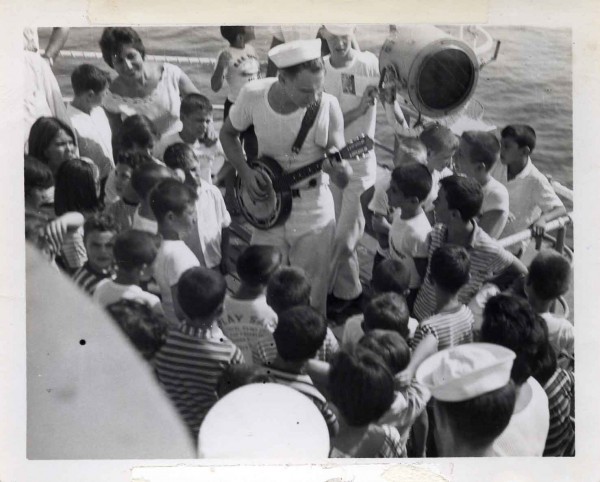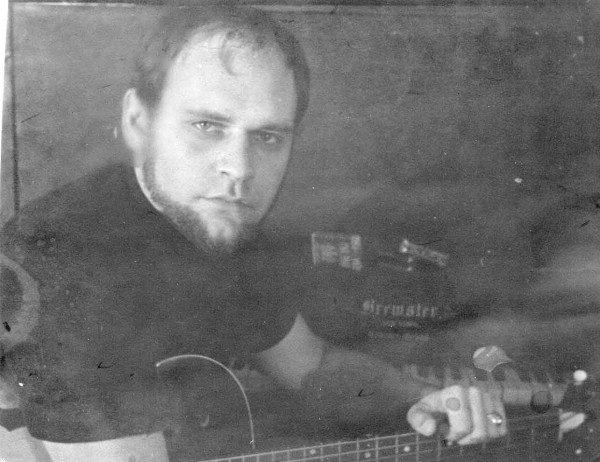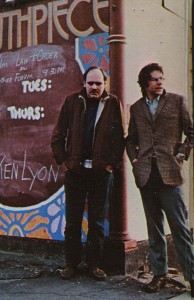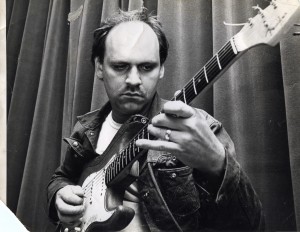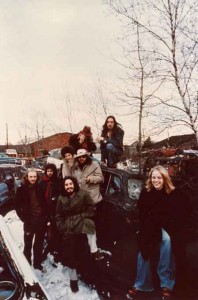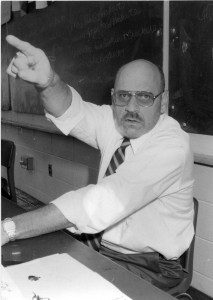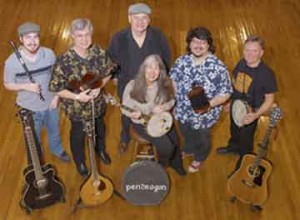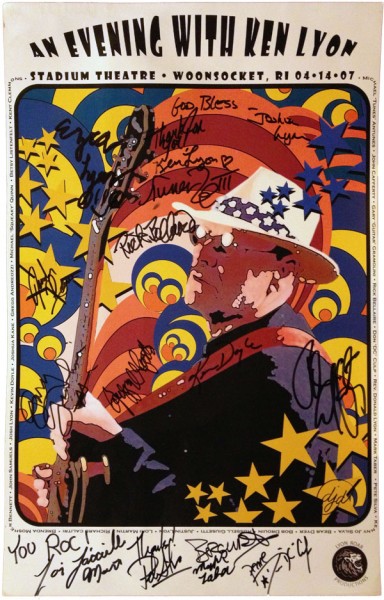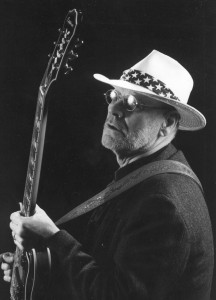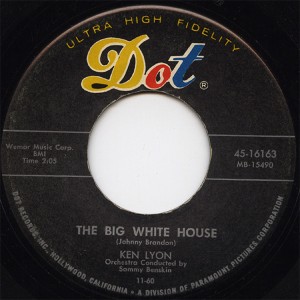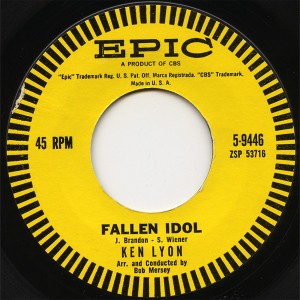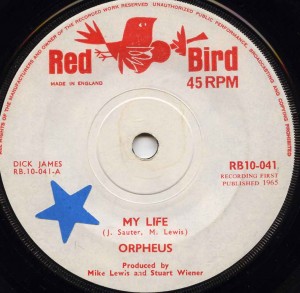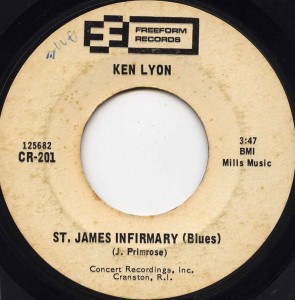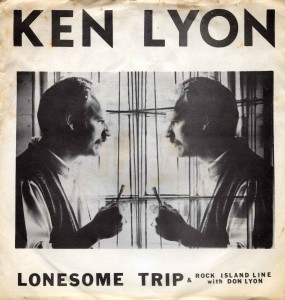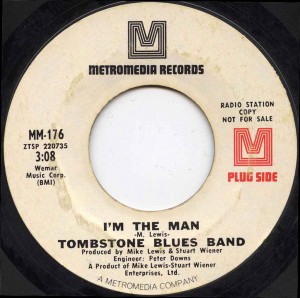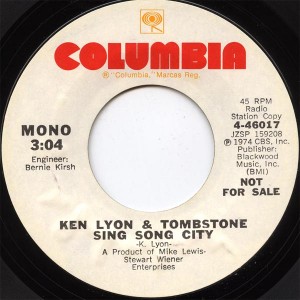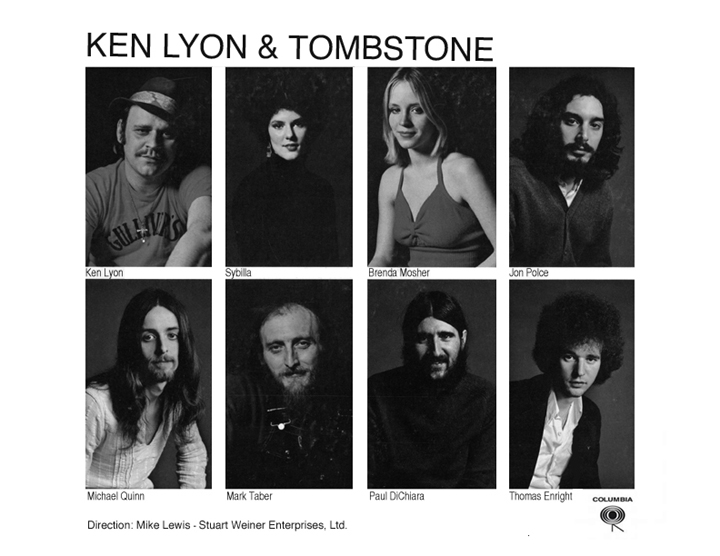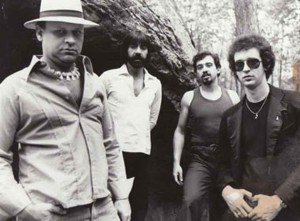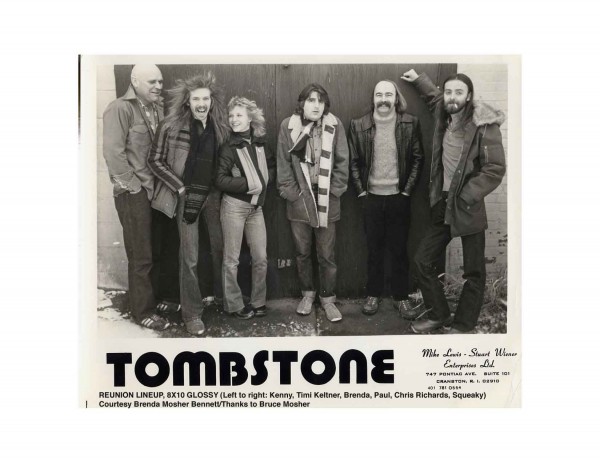Ken Lyon/The Tombstone Blues Band/Ken Lyon & Tombstone
2012 INDUCTEE
Folk/Blues/Rock ‘n’ Roll
KEN LYON (1941-2021)
A Man & His Music
by Pete Silva and Rick Bellaire
It’s 1941 in Newport, Rhode Island. Franklin Delano Roosevelt is sworn in to his third term as president. A pound of coffee is twenty-four cents and a brand new Chevy wagon sells for under a thousand dollars. War is raging in Europe. Changes are in the wind, and back home in Newport, RI, something very special happens. A musical legend is born. A musical legend named Ken Lyon.
Born to musical parents, at only three years old, Ken begins vocal studies with his classically trained mother. By his fifteenth birthday, Ken finally lays his hands upon his first folk guitar, a Stella. He teaches himself to play and connections are made; the crucial connections between voice and music. Thus begins Ken’s musical journey; a journey that will influence musicians for decades to come.
It’s now 1958. High school teenagers John Lennon, Paul McCartney and George Harrison are wood shedding in the front room placing them squarely at the forefront of the blossoming folk/blues scene in England, Skiffle Music; and clear across the Atlantic, high school teenagers Ken Lyon and Billy Allen form a musical duo called “The Seniors”. Along with others on the same wavelength, such as Ken’s brother Don, this places Lyon squarely at the forefront of the burgeoning American Folk/Blues Revival scene.
It’s now 1960 and America is ready for great change. Camelot is approaching and with it the idea that the American Dream can come true. For Ken Lyon, the dream is becoming reality. Taking cues from important folk revival acts such as the Brothers Four and the World Music folk alchemy of Harry Belafonte, Ken now assumes the persona of “Calypso Ken.” He makes his first professional appearance performing in summer evening floor shows at Ted Hilton’s Dude Ranch in Moosup, Connecticut. In a few short months he finds himself at New York’s famed Brill Building, home to such writers and performers as Carole King, Paul Simon and the Neils – Sedaka and Diamond. Song publisher George Weiner of Wemar Music recognizes Ken’s songwriting talents and immediately signs him to a publishing contract. Ken’s star rises quickly, and in less than a week, Weiner’s son Stuart offers him a second contract – this time as a singer. Ken Lyon has hit the big time.
Remember the 45? It was the heart and soul of the hit record. Ken Lyon takes his first shot at stardom with “The Big White House”, and with Dot Records distributing the new single nationwide, Ken finds himself marketed as the new up and coming pop star. He shares the artist roster with Dot’s hottest teen idol, Pat Boone.
1961 finds Ken still heading for stardom. Stuart Weiner finds another song for him, called “Fallen Idol.” And with the new song came an even bigger record deal as Ken is signed to the Epic label. Again, he shares the roster with another teen idol, Bobby Vinton. “Fallen Idol,” recorded with Vinton’s own musicians and arranger, makes waves on the music scene. Epic sends Ken on his first national promotional tour sharing the bill with The Brothers Four and Gary “U.S.” Bonds. The single hits #2 in Vancouver, British Columbia and reaches number twenty nationwide in Canada, it’s #2 in Baltimore and is heard nationwide on Dick Clark’s American Bandstand.
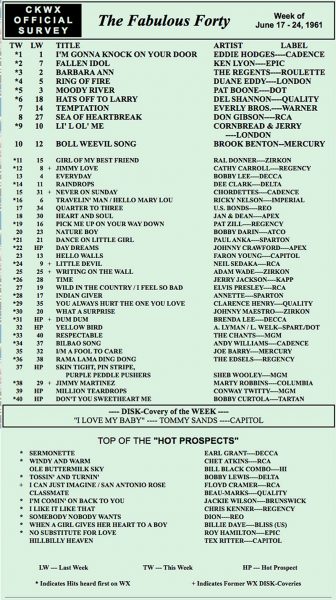
Kenny reached #2 in the Pacific Northwest in 1961. Unfortunately, the promotional tour he was on never reached the west coast.
But the commercial side of Epic Records, stardom, and the music business was not part of Ken’s destiny. In the fall of 1961 he finds his way back to New England in search of his folk roots in Cambridge, Massachusetts – the epicenter of the growing underground American Folk Revival scene. Here Ken meets and works with such stars such as Tom Rush, and Sonny Terry & Brownie McGhee. It’s here, in Cambridge, that Ken Lyon pens his first important song, the future classi “Dusty Road.” This song proves to be the starting point for all things musical that Ken becomes.
By now it’s 1962. The Berlin Wall divides Germany; Kennedy stares down Kruschev during the Cuban Missile Crisis; and the country learns it won’t “have Dick Nixon to kick around anymore.” And, unfortunately, the Cambridge folk scene won’t have Ken Lyon around anymore. Ken, a Naval Reservist since high school, is called up for active duty. He spends the next two years sailing the Atlantic, the Mediterranean, and the Caribbean. Despite this interruption, Ken forms a band and entertains people in ports around the world.
Back home by 1964, he quickly signs on as the bass player with the region’s top club band, Albi & The Spellbinders. The steady club work enabled Ken to work on his own music during the day and make occasional forays into New York City looking for a record deal. When a deal fails to materialize, Ken figures he’d do better if he was on the scene in the Big Apple and decides to follow his heart back to folk music, settling in New York’s bohemian center, Greenwich Village.
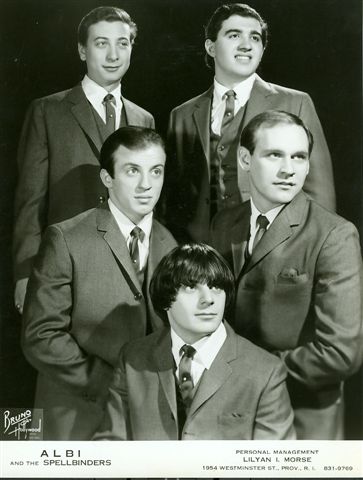
The original lineup of Albi & The Spellbinders circa 1965: Albi Manfredi at bottom center, multi-instrumentalist Diamond Centofanti at top right and Ken Lyon at right center
It’s here, in the Village, that Ken meets Noel “Paul” Stookey of Peter, Paul & Mary and finds a lifelong friend in kindred spirit Richie Havens. While Ken performs at such legendary venues as Café Wha? and Gerde’s Folk City, Stu Weiner once again secures a record deal. This time it’s with Leiber & Stoller’s Red Bird Records. They cut the folk-rock single “My Life” and market Ken under the persona, “Orpheus.”
Again Ken is at the forefront of the music scene. The sound and marketing pre-date the San Francisco Psychedelic movement by an entire year. But the record was deemed too similar to “It’s My Life” by The Animals and the release was canceled after the initial pressing. The years 1965 and 1966, however, prove to establish Ken’’s status as a contender. He returns home in 1966, rejoins The Spellbinders and solidifies his most enduring and successful partnership: he marries Alicia Orzechowski. Ken also begins performing solo and with his brother Don playing harmonica. They perform at countless coffeehouses and colleges throughout New England.
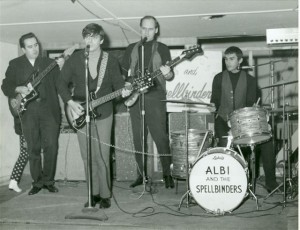
Ken rejoins The Spellbinders seen here in 1966 at The Beachcomber in Narragansett, Rhode Island: (left to right) Jim Ryan, Albi, Ken and Baby Ray Jordan
Although The Spellbinders’ great frontman and founder, Albi Manfredi, passed away in 2007, the group is still going strong. These historic photos appear here courtesy of longtime band member Bruce “Rooster” Perry. Readers are encouraged to visit the band’s website to learn more about one of the finest and longest-running acts in Rhode Island music history: http://www.thespellbinders.com
In late ’66, Ken finds some success with an independent single, “St. James Infirmary”. Encouraged, in 1967 he releases another independent single, called “Lonesome Trip.” Ironically, it’s the B-Side of the 45, “Rock Island Line,” that becomes an accidental hit when the jocks in southern New England start flipping the record. The song quickly becomes a staple in his repertoire and one of his most-requested numbers to this day. This cements his position as the number one folk singer in the region, but just as there are two sides to the classic 45, there were always two sides to Ken Lyon: the ever-present folk singer and the explorer of the electric blues. And this is what made 1967 so remarkable. It was here that the Ken Lyon’’s “B-Side” found its place in Rhode Island music history. And what a year it was! Walter Cronkite delivered the news about the Vietnam War while “Sgt. Pepper” declared martial law over the radio airwaves. And Ken is present at the birth of New England’s electric blues scene when he forms The Tombstone Blues Band.
The band consists of the finest players on the Rhode Island scene. Along with Ken on vocals is future guitar legend Mike “Duke” Robillard (then known as “Honey Bear”), Al Lobello on bass and vocals, Tommy DeQuattro on drums, harmonica virtuoso Steve Nardella, and on piano, Ken’s lifelong friend and longest-running collaborator Mark Taber.
The Tombstone Blues Band takes New England by storm with their powerful live shows. This once again attracts the interest of Stu Weiner along his new partner, Mike Lewis. And again, the lure of national status calls out to Ken. Weiner and Lewis produce a single for Metromedia Records.
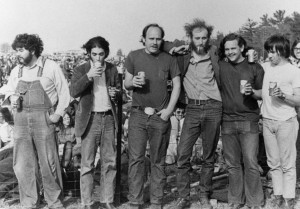
The original lineup of The Tombstone Blues Band 1968 (left to right): Mike “Honey Bear” Robillard, Steve Nardella, Ken Lyon, Mark Taber, Al Lobello & Tommy DeQuattro
The deal promises to be the biggest commercial opportunity for Ken Lyon to date, and in 1968 he releases “I’m The Man.” But commercialism and musical integrity are often mutually exclusive and Ken, unhappy with the single, declines to cut an album and tears up his contract. Still, The Tombstone Blues Band, with its stellar lineup, continues to pack clubs. But it’s Ken’s drawing power as an acoustic artist that overshadows his success with the band. Lewis and Weiner see this and decide to concentrate on Ken’s acoustic career and, once again, secure a deal. This time it’s on the Decca label. It’s now 1969, a year at the threshold of a new decade and a new beginning. And so it is for Ken Lyon.
His live shows are renowned, and with help from Don “Little Brother” Lyon on harmonica, he records a live acoustic album at The Mouthpiece Coffeehouse in Providence.
1970 finds the international release of “Ken Lyon in Concert.” He performs at the MCA annual showcase convention with another new signing, Elton John. However, the business end of music once again dominates Ken’s fortunes. Decca folds, and he becomes a corporate casualty. On the electric front, Robillard leaves Tombstone to form the original Roomful Of Blues and is replaced by local guitar legend Phil Greene; Nardella forms his own band and is replaced by future tenor sax jazz master Scott Hamilton, then a blues harmonica prodigy and still in high school. Finally, between 1971 and 1972, the remaining original players in the Tombstone Blues Band move on.
Ken decides to pursue a teaching degree. He unplugs the electric, but continues to perform as an acoustic artist.
But the tubes in his old Fender amp never go cold, and in 1972 Ken hand-picks the lineup for a new electric band to be called simply Ken Lyon & Tombstone.
He begins by reuniting and enlisting, en masse, the entire lineup of one Rhode Island’s greatest-ever bands, Flesh, which had then recently broken up after failing to attract major label attention: Al Lobello (from the original Tombstone Blues Band) on bass, Michael “Squeaky” Quinn on drums, Paul DiChiara (formerly of Hot Cottage) on lead guitar and vocalist/guitarist Jon Polce. Next, he added a second lead guitarist, Thom Enright (fresh off a major label deal with the Boston band Shakey Legs) and his loyal friend and most-frequent collaborator, pianist Mark Taber. Filling out the group would be two female vocalists, Brenda Mosher and Sybilla (Hyde) who would not only provide soulful, gospel-inflected backing vocals, but share in the lead vocals as well. During the early rehearsal stages, Al Lobello leaves the band due to musical differences and Ken picks up the bass guitar again for the first time since The Spellbinders. The new band is unlike anything on the club circuit at the time and the reaction is immediate. Ken Lyon & Tombstone explode onto the scene and quickly become one of the area’s top attractions.
As fate would have it, Lewis and Weiner, in town on business with their other Rhode Island-based act, R&B legends Rhythm, decide to say hello to Ken at his regular gig at the Bon Vue Inn in Narragansett, Rhode Island. As they approach the venerable beach bar, the line to get in is blocks-long and circles around Aunt Carrie’s famed fish house. Astounded, Lewis and Weiner make their way through the crowd only to find the house rockin’ with Ken’’s new Tombstone lineup. They act quickly and contact Columbia Records. A three-album deal is signed and recording begins.
The album receives worldwide critical praise. The single, “Sing Song City,” becomes an FM radio favorite and charts in Europe and Australia. Sales are brisk, and the band hits the road with headliners Mott the Hoople, and opening act Queen on their first American tour. The crowds and the reviewers agree: Ken Lyon & Tombstone can hold their own in any venue and is a band on the edge of stardom.
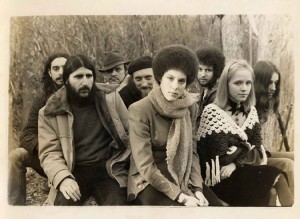
Ken Lyon & Tombstone, Columbia Records publicity photo, 1973 (left to right): Jon Polce, Paul DiChiara, Ken Lyon, Mark Taber, Sybilla, Thom Enright, Brenda Mosher & Michael “Squeaky” Quinn
1974 brings continued success on the road and a second album is recorded. But the words “music” and “business” clash and Ken Lyon once again finds himself on the wrong side of a business decision – the band is dropped by Columbia during a corporate makeover.
The group soldiers on, touring throughout the U.S. Lewis and Weiner attempt to secure another deal using the unreleased second album as a calling card. They were successful in six previous attempts, however, the seventh time is not a charm They find no imminent interest and the master tape fades into obscurity.
1975: the Vietnam War ends, Jimmy Hoffa disappears, Bruce Springsteen makes the covers of Time and Newsweek, Saturday Night Live is born and disco won’t die. It’s now been eight years since the forming of the original Tombstone Blues Band. Ken finally earns his graduate degree and relocates to Hawaii where he takes time off from the music business and teaches school for several years. By the end of the tumultuous seventies, Ken finds himself back in Rhode Island. For the next decade he concentrates on family, teaching and the occasional gig, either solo or with his old friend Mark Taber.
Fast forward ten years: the ’80s have come and gone. Ken, though not really in musical retirement during this decade, is hard-pressed to find an audience – it’s just so hard to leave the house when Madonna and Miami Vice are “must see” TV and an actor is president!
Well, maybe it wasn’t so bad …after all, a bunch of guys from Narrangansett, John Cafferty & The Beaver Brown Band, did pretty well after spending ten years blowing the roofs off every bar in town like Gulliver’s and the Bon Vue and found international success with the surprise double platinum sales for their soundtrack album to the cult film Eddie & The Cruisers. Taking his cue from them, Ken decides it’s time to make music again and returns to the music scene on two fronts:
He joins New England’s finest Celtic band – the internationally renowned Pendragon, and he forms a new group, Ken Lyon & The Tombstone Blues Band. Ken returns to the studio and releases a best-selling album, “Up from the Ashes,” featuring a stellar lineup of Rhode Island’s finest players and produced by legendary board man Phil Greene.
(Greene had gone on from the Tombstone to lead his own fine band, Swallow, but when they were dropped after two albums for Warner Brothers, he had moved behind the scenes and established himself as one of New England’s finest recording engineers and record producers.)
As of this writing (August, 2007), for the last sixteen years, Ken Lyon has been a vital elder statesman on New England’s musical landscape. He has reclaimed his position on the folk scene as a solo act and as a member of Pendragon, and on the electric blues scene with various Tombstone lineups and as host of a regular blues jam session at Chan’s, the legendary jazz club in Woonsocket, Rhode Island.
On the occasion of his 66th birthday, April 14, 2007, Ken is presented, in concert, at The Stadium Theatre in Woonsocket, Rhode Island. A near sell-out for the thousand seat hall, the event, entitled “An Evening With Ken Lyon: A Musical Retrospective,” chronicles his career and success, from “The Big White House” all the way to the debut of his latest acoustic project, The Shoe Fly Orchestra.
Ken’s friends and family celebrate the ups, the downs, and all points in between of a musical legacy that has endured for almost fifty years.
Since the retrospective, popular demand called for encore performances by Ken Lyon & Tombstone with the lineup featuring original members Mark Taber and Brenda Mosher Bennett and most of the participants from the Stadium Theatre concert. Ken dubbed the unit “Tombstone Class of 2007”, but quickly proclaimed the band as “graduates” after just a couple of shows and the personnel gelled into a permanent unit through 2009.
Ken Lyon has always been a multi-faceted artist; and like most artists, he prefers to present only one side at a time in order to showcase his creative focus. Also, like most artists, he prefers to look forward, not revisit the past. With this career-spanning presentation in the past, Ken is poised to continue his explorations in American popular music and is looking forward to new recording and performing opportunities which will continue to challenge and drive him to new heights.
To his fans, friends and family, Ken Lyon remains the man who paved the road out of town, but never forgot his way back home.
– Originally presented at the Ken Lyon retrospective concert, April 14, 2007 and updated in 2011
THE KEN LYON DISCOGRAPHY
1960
KEN LYON
Dot Records 45-16163
A. The Big White House
B. Don’t Believe Everything You Hear
1961
KEN LYON
Epic Records 45-9446
A. Fallen Idol
B. Oh Father
1965
ORPHEUS
Red Bird Records 45-RB10-041
A. My Life
B. Music Minus Orpheus
1966
KEN LYON
Freeform Records 45-CR-201
A. St. James Infirmary (Blues)
B. Night Winds Howl
1967
KEN LYON
Viscount Records 45-PD-104672
A. Lonesome Trip
B. Rock Island Line
1968
THE TOMBSTONE BLUES BAND
A. I’m The Man
B. Rollin’ and Tumblin’
Metromedia Records 45- MM-176
1970
KEN LYON IN CONCERT
Decca Records LP-DL-75197
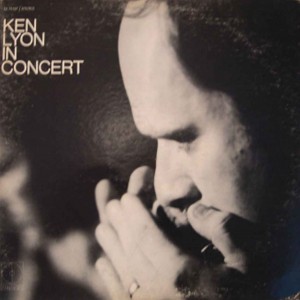 Side A
Side A
1. Muscle In My Arm
2. Homeward Bound
3. Volkswagon Blues
4. Perci The Dragon
5. Girl From The North Country
6. San Miguel
7. The Riddle Song
Side B
8. Dusty Road
9. Bad Bad Whiskey
10. Scotch And Soda
11. He Was A Friend Of Mine
Produced by Mike Lewis & Stuart Weiner
1974
KEN LYON & TOMBSTONE
KEN LYON & TOMBSTONE
Columbia Records LP-KC-32910
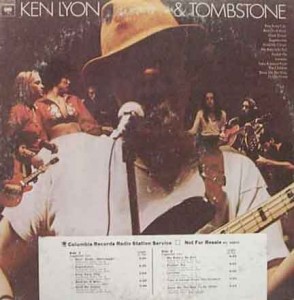
Side A
1. Goin’ Down (Hallelujah)
2. Sugarbones
3. Sing Song City
4. Bird On A Wire
5. Hold Me Closer
Side B
6. My Baby’s So Evil
7. Punkin’ Pie
8. Lorraine
9. Take A Lesson From The Children
10. Show Me The Way To Go Home
Produced by Mike Lewis & Stu Weiner
1974
KEN LYON & TOMBSTONE
Columbia Records 45-4-46017 (White Label Promo)
A. Sing Song City (Mono)
B. Sing Song City (Stereo)
Columbia Records 45-4-46017 (Stock Copy)
A. Sing Song City
B. Lorraine
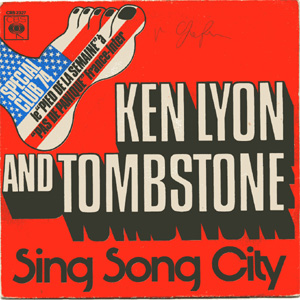 Released worldwide on CBS – shown is the French pic sleeve
Released worldwide on CBS – shown is the French pic sleeve
1990
KEN LYON & THE TOMBSTONE BLUES BAND
UP FROM THE ASHES
Bootstrap Records CD-AVL-90030
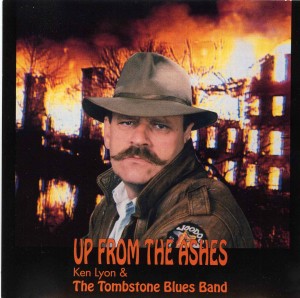
1. Talkin’ To My Baby
2. Long Lost John
3. Daytona Blonde
4. Don’t Have To Go
5. Maybelline
6. Waterboy
7. Baby I Love You So
8. Elvyra
9. Riot In Cell Block #9
10. Long Distance Call
11. Tombstone Blues Band (King Of The Graveyard Boogie)
Produced by Ken Lyon & Phil Greene
2003
KEN LYON:
OLD SCHOOL
Rogues Island CD-61166
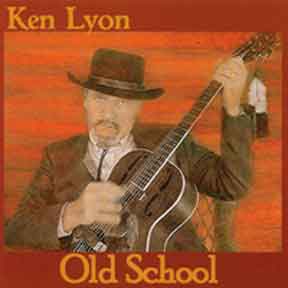 1. Holy Land
1. Holy Land
2. Back To Texas
3. Special Rider
4. Spend A Dream With You
5. Scotch & Soda
6. Dream Lover
7. Lookin’ For Trouble
8. This Time
9. You Left The Water Running
10. Lonesome Town
Produced by Carl “The Eggman” Eggert
2007
KEN LYON
THE BEST OF KEN LYON VOLUME 1
Lyon Roar Productions
 KEN LYON
KEN LYON
1. The Big White House
2. Fallen Idol
ORPHEUS
3. My Life
KEN LYON
4. St. James Infirmary (Blues)
5. Rock Island Line
THE TOMBSTONE BLUES BAND
6. I’m The Man
KEN LYON
7. Volkswagon Blues
8. Perci the Dragon
9. Dusty Road
KEN LYON & TOMBSTONE
10. Goin’ Down (Hallelujah)
11. Sugarbones
12. Sing Song City
13. My Baby’s So Evil
14. Cocaine
15. Who Do You Love
KEN LYON & THE TOMBSTONE BLUES BAND
16. Baby I Love You So
KING COTTON
17. Killing Floor
2008
KEN LYON & TOMBSTONE
LIVE 1975
Lyon Roar Productions
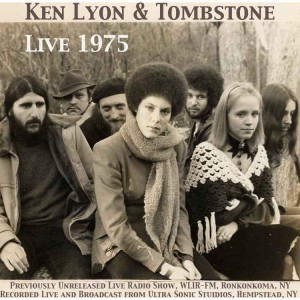 1. One Monkey Don’t Stop No Show
1. One Monkey Don’t Stop No Show
2. Make Me A Pallet on Your Floor
3. Love Me Like A Man
4. My Baby’s So Evil
5. Wholesale Dealin’ Mama
6. Money Honey
7. Who Do You Love
8. Cocaine
A Lyon Roar Production
2007
KEN LYON
THE SINGLES COLLECTION
Lyon Roar Productions
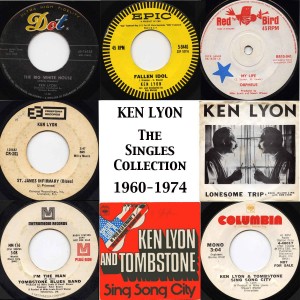 1. The Big White House
1. The Big White House
2. Don’t Believe Everything You Hear
3. Fallen Idol
4. Oh Father
5. My Life
6. Music Minus Orpheus
7. St. James Infirmary Blues
8. Night Winds Howl
9. Lonesome Trip
10. Rock Island Line
11. I’m The Man
12. Rollin’ and Tumblin
13. Sing Song City
2008
AN EVENING WITH KEN LYON:
A MUSICAL RETROSPECTIVE
Lyon Roar Productions DVD
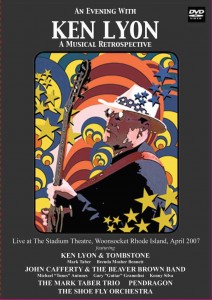 2009
2009
KEN LYON
STELLA AND ME
Wolf Bear Productions
 1. Walk Right In
1. Walk Right In
2. Statesboro Rag
3. Pallet
4. John Hardy
5. Diamond Joe
6. Down And Out
7. Ole Blue
8. Los Brazos
9. Leadbelly
10. Saturday’s Child
11. Treated This Way
12. St. James Infirmary
13. Killing Floor
Produced by Lori Lacaille Martin
Executive Producer: Alexander Arabian
KEN LYON: BIOGRAPHICAL TIMELINE
1941
Ken Lyon born in Newport, Rhode Island
Father: Jazz drummer, fireman, Methodist/Episcopal preacher Walter Kenneth Lyon, Jr.
Mother: Classical singer Ruth Popple.
1944
Begins vocal studies with mother Ruth.
1956
Acquires first guitar, a Stella acoustic, begins to teach himself to play using a Stephen Foster songbook with chord fingerings.
1957
Forms folk music duo, The Seniors, with Billy Allen.
1959
Begins performing as a folk artist playing the music of The Kingston Trio and Harry Belafonte.
1960
Makes his first professional appearance as a musician performing as “Calypso Ken” during the evening floor shows for the summer colony at Ted Hilton’s Dude Ranch in Moosup, Connecticut. He performs the music of Harry Belafonte and other popular folk-revival acts of the day including The Brothers Four.
Makes his first professional recording, a demo, at Audiosonic Studios in the Brill Building, New York City.
Demo leads to song publishing contract with George Weiner’s Wemar Music.
Weiner’s son Stuart recognizes Ken’s talents as a singer, and signs him to as an artist to his production company. Using a demo (cut by a teenage Paul Simon, then known as Jerry Landis), Lyon records his first record, “The Big White House.” The master is leased to Dot Records and the single is released nationally. The record fails to chart and Lyon is dropped from the label.
1961
Stuart Weiner finds another song for Ken, “Fallen Idol,” and Lyon is signed to Epic Records. This single fares much better than the Dot release and Ken embarks on a national tour doing radio promotion and performing at record hops with such contemporaries as Gary “U.S.” Bonds and The Brothers Four. Despite repeated plays on Dick Clark’s American Bandstand, a #1 chart placement in Baltimore, and a Top 20 placement on the Canadian Top 40 due to heavy rotation in Toronto, the record fails to reach the Billboard Hot 100 and Lyon is dropped from Epic.
In the fall, Lyon relocates to Cambridge, Massachusetts and fares well on the budding folk music coffeehouse scene in Central Square, Harvard Square and Boston. He rubs shoulders with many of the stars and future stars of the folk-revival era, working with Tom Rush, Jerry Corbett of The Youngbloods, The Charles River Valley Boys, Sonny Terry & Brownie McGhee, Judy Roderick, Mike Seeger & The New Lost City Ramblers, and The Holy Modal Rounders.
Lyon composes his first “important” song during this era, the future classic, “Dusty Road.”
1962
A naval reservist since high school, Lyon is called up for active duty. He spends the next two years sailing the Atlantic, the Mediterranean and the Caribbean. He formed a band, Ken Lyon & The Tiger Bay Trio with Mark Lyon (no relation), the bass player from Faron Young’s band and a drummer. The group performs at shipboard functions and takes engagements in clubs whenever the ship made port.
1964
Fresh out of the Navy, Lyon returns to Rhode Island and joins one of the area’s top bands, Albi & The Spellbinders, on bass guitar. The Spellbinders make frequent trips to Manhattan and despite record label interest, no record deal was secured.
1965
Lyon relocates to Greenwich Village. He meets Noel “Paul” Stookey of Peter, Paul & Mary and finds a lifelong friend in kindred spirit Richie Havens. He makes significant inroads into the scene performing at Cafe Bizarre, Cafe Wha? and Gerde’s Folk City. Stu Weiner once again secures a record deal for Ken. They cut the folk-rock single “My Life” under the name Orpheus for Leiber & Stoller’s Red Bird Records supervised by label executive Charles Koppelman. The record is deemed too similar to The Animals’ “It’s My Life” and the release is canceled after only a few promo copies were shipped to radio stations.
1966-1969
Returning to Rhode Island, Ken marries and begins performing as a solo or with his brother, Don Lyon on harmonica, at countless coffeehouses, pubs and colleges throughout New England. He releases two independent singles, “St. James Infirmary” and “Rock Island Line” which cement his position as the number one folk singer in the region.
During this time, anxious to explore the electric side of the blues, Lyon forms the original Tombstone Blues Band in 1967 with guitarist Mike “Honey Bear” Robillard, drummer Tommy DiQuattro, bass guitarist Al Lobello, and harmonica virtuoso Steve Nardella. The addition of local legend Mark Taber on piano marks the beginning of their lifelong friendship and collaboration.
Their powerful live shows lead to renewed interest from Stu Weiner along with his new partner, Mike Lewis. The pair produces a three-song session and manages to secure a deal with Metromedia Records then riding high with TV star Bobby Sherman. Unhappy with the failure of the resulting single, Lyon opts out of the deal.
Despite the stellar lineup and their success on the local club scene, Ken’s drawing power as an acoustic artist had always overshadowed Tombstone. Lewis & Weiner decide to concentrate on that side of Ken’s career and the pair is able to secure a deal with Decca Records. Ken records an acoustic, live album – with help from Don “Little Brother” Lyon – at The Mouthpiece coffeehouse in Providence.
1970
“Ken Lyon In Concert” is released on Decca Records. Ken performs at the MCA Annual Convention (along with another new signing, Elton John) to showcase the album for the promotion and sales teams. Despite significant worldwide sales and airplay, the album is lost in the shuffle during a corporate shakeup which results in the Decca and Uni labels being folded into a new, mega-label, MCA Records. Lyon is dropped by MCA.
Lyon arranges, organizes the band and co-produces with Lewis & Weiner an album for his friend and collaborator, Jay Bolotin. The self-titled LP on Commonwealth United fares well and Bolotin performs for several years, with Lyon and as a solo, but ultimately opts out of the music business to pursue woodcutting and sculpture.
1971-1972
The original Tombstone Blues Band disbands with Robillard joining the fledgling Roomful of Blues and Nardella moving on to a successful solo career. Lyon continues to perform as an acoustic single throughout the area while attending college in pursuit of a teaching degree.
1973
Eager to play electric music again, Lyon forms Ken Lyon & Tombstone with drummer Tommy DiQuattro and bass guitarist Al Lobello. An ever-changing, ever-evolving lineup soon solidified into the area’s top club attraction with the additions of lead guitarist Paul DiChiara, second guitarist Thom Enright, Mark Taber once again on piano, drummer Michael “Squeaky” Quinn, singer-songwriter Jon Polce, vocalists Brenda Mosher and Sybilla, and Ken himself on bass guitar.
Lyon’s producers, Mike Lewis & Stuart Weiner, in Rhode Island on business with their other area act, the self-contained R & B band Rhythm, decide to drop in on the band at their steady gig, The Bon Vue Inn in Narragansett, Rhode Island. They come upon a blocks-long line trying to gain admission. As soon as they heard the new lineup and saw the crowd’s reaction, they knew it was time to act and act quickly. They contact their associate from the Red Bird deal, Charles Koppelman, who had recently replaced the fired Clive Davis as head of Columbia Records. A three album deal is secured and recording for the first album begins.
When released, the album receives glowing reviews in the rock press all over the world. The single, “Sing Song City,” was an FM radio favorite and charted in France and Australia. Early sales are brisk. Ken Lyon & Tombstone tour North America on a bill headlined by Mott The Hoople with opening act Queen on their first tour. Crowd reaction is tremendous at every date and reviewers hail the act as a first-rate live attraction and a group on the horizon.
1974
With satisfactory sales and a rapidly growing fan-base, the band records their second album, but it was not to be. Koppelman, never a popular executive at Columbia due to the large number of Davis loyalists still on staff, leaves the label at that point. The new regime decides to reorganize and begins by dropping all of the acts signed by Koppelman.
Riding on their reputation, the group soldiers on, playing successful dates in major markets all over the U.S. Meanwhile, Lewis & Weiner attempt to secure another deal using the unreleased album as a calling card, but they find no interest at the labels.
1975
Ken Lyon & Tombstone disbands. Ken enrolls in a graduate program to study for his teaching degree. He keeps the name alive with a 4-piece lineup called simply Tombstone retaining Thom Enright on guitar and vocals, enlisting multi-instrumentalist Diamond Centofanti on keyboards and reeds, and calling up original Tombstone Blues Band drummer Tommy DiQuattro into active service.
After receiving his degree, he moves to Hawaii where he teaches school for several years. His primary musical endeavor is learning to play slide guitar under the tutelage of Hawaiian master Bo Kalima.
1979
Ken Lyon returns to Rhode Island and forms a new band called simply Tombstone with Paul DiChiara, Squeaky Quinn and Brenda Mosher from the last lineup along with new recruits, guitarists Chris Richards and Timi Keltner. The reception is lukewarm and the group disbands within the year.
1980-1990
Lyon concentrates on his family and teaching, performing only occasionally as a single or in a jazzy trio setting with old friend Mark Taber.
1990s-2000s
Lyon returns to the music scene on two fronts: he joins Pendragon, the finest and most popular Celtic band in New England, and forms a new group, Ken Lyon & The Tombstone Blues Band, with a stellar core lineup of area heavyweights: Mark Taber on piano, guitarist Ed Vallee, Bruce Mosher on bass guitar, drummer George Correia, and Jim “Killer” Kane on harmonica.
He returns to the studio and the group releases a best-selling, independent album, “Up From The Ashes” produced by Phil Greene.
For the last sixteen years, Lyon has been an important, elder statesman on New England’s musical landscape, reclaiming his crown on the folk scene as a solo and with Pendragon, and on the blues scene with the aforementioned Tombstone and other lineups including The Outriders with drummer Don Culp and, of course, Mark Taber. He also got behind the board to produce several releases by a new generation of Lyons – the band Triton fronted by his sons Alexander and Joshua Lyon. In 2003, he released a stripped-down album of rootsy Americana, “Old School”, produced by drummer and WRIU DJ Carl “The Eggman” Eggert.
As of this writing (January, 2007), Lyon is still performing with Pendragon, as a solo, and with The Mark Taber Trio, and hosts a blues jam at Chan’s jazz club in Woonsocket, Rhode Island. He unveiled his new, eclectic, acoustic group, The Shoe Fly Orchestra, this year.
On April 14, 2007, his 66th birthday, Ken Lyon was presented in concert for a musical retrospective at The Stadium Theatre in Woonsocket, Rhode Island. He was joined by a stellar cast of associates – musicians and friends from every era of his career including Mark Taber, Brenda Mosher Bennett, Pendragon and John Cafferty & The Beaver Brown Band.
Key Lyon passed away January 6, 2021.
LINKS & RESOURCES
KEN LYON MUSIC: Official YouTube Channel
https://www.youtube.com/channel/UCo3HCn7Iz5Bo1ZJJxk4ROWA
The Lyon family has posted nearly all of Ken’s officially released recorded output on YouTube plus live recordings and previously unreleased material with the promise of more to come. Ken’s work is essential listening for fans and students of Rhode Island music history and the channel is a great resource. The recordings feature a revolving door of some of the finest homegrown musicians of the second half of the 20th century including several other Rhode Island Music Hall of Fame-ers such as Duke Robillard and Brenda Bennett.
Discography
